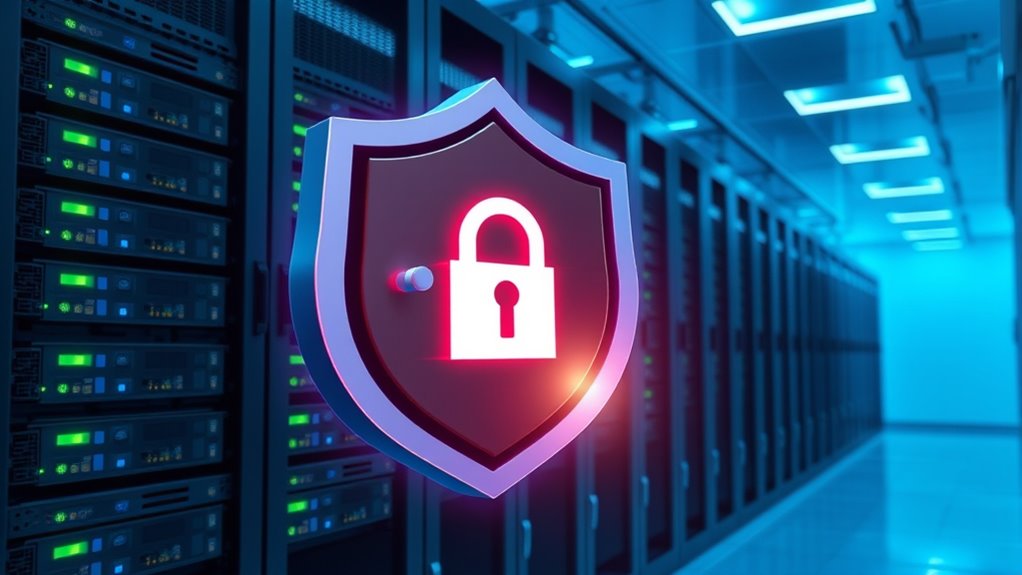To securely store cardholder data, you should encrypt sensitive information both at rest and in transit using industry-standard algorithms like AES and TLS. Implement strict access controls based on roles, use multi-factor authentication, and regularly review permissions. Strengthen physical security with monitored, restricted areas, and employ data masking or tokenization to reduce sensitive data exposure. Make certain your staff is trained on security policies. Continuing will help you understand additional layers to keep data safe.
Key Takeaways
- Encrypt all cardholder data both at rest and during transmission using industry-standard protocols like AES and TLS.
- Implement strict access controls, including role-based permissions and multi-factor authentication, to limit data access.
- Store data in physically secure environments with restricted access, monitored through regular audits and access logs.
- Use data masking and tokenization to minimize exposure of sensitive information in storage and processing.
- Maintain comprehensive security policies and conduct regular staff training on data protection best practices and threat awareness.

Protecting cardholder data is crucial for maintaining trust and complying with industry standards. When you handle sensitive payment information, implementing robust security measures becomes your top priority. One of the most effective ways to safeguard this data is through the use of strong encryption protocols. By encrypting data at rest and in transit, you guarantee that even if unauthorized individuals access your storage systems, they can’t read or misuse the information. Encryption protocols like AES (Advanced Encryption Standard) and TLS (Transport Layer Security) are industry standards that provide strong, tested security for your data. They act as a critical line of defense, making it considerably more difficult for hackers to decipher encrypted information without the appropriate keys.
Encrypting data at rest and in transit with AES and TLS is essential for safeguarding cardholder information and maintaining trust.
Alongside encryption, access controls are essential. You need to restrict who can view, modify, or handle cardholder data within your organization. Implementing role-based access controls ensures only authorized personnel can access sensitive data, based on their job responsibilities. For example, customer service staff may need limited access, while IT security teams require broader permissions. This minimizes the risk of accidental exposure or malicious insider threats. Multi-factor authentication further enhances access controls by adding an extra layer of verification, making it harder for unauthorized users to gain entry even if they have compromised login credentials. Regularly reviewing and updating access permissions is equally important to prevent lingering access for employees who no longer need it.
In addition to encryption and access controls, you should consider implementing physical security measures. Store cardholder data in secure, monitored environments with restricted access, such as locked server rooms or data centers with biometric entry. Regular audits and monitoring of access logs help identify unusual activity early, so you can respond before any breach occurs. Data masking and tokenization are also powerful techniques; they replace sensitive information with non-sensitive placeholders, reducing the amount of exposure if a breach does happen.
Finally, make sure your security policies are extensive and up-to-date. Train your staff regularly on data security best practices, emphasizing the importance of safeguarding cardholder information. Staying current with industry standards like PCI DSS ensures your protective measures remain effective against evolving threats. When you combine encryption protocols, strict access controls, physical security, and ongoing staff training, you’re creating a layered defense that markedly reduces the risk of data breaches and builds trust with your customers.
Frequently Asked Questions
How Often Should Encryption Keys Be Rotated?
You should rotate encryption keys regularly, typically at least once a year, to minimize risks. Key rotation is a a vital part of managing the encryption lifecycle, ensuring that compromised keys don’t expose sensitive data. Implement automated processes for key rotation whenever possible, and review your rotation schedule periodically based on security changes or emerging threats. This proactive approach helps maintain the integrity and confidentiality of your cardholder data.
What Are the Latest PCI DSS Compliance Requirements?
You need to stay current with PCI DSS compliance requirements, which now emphasize robust tokenization methods and data masking techniques to protect cardholder data. Regularly review updates, implement strong encryption, and guarantee access controls are in place. You should also document your security measures, conduct vulnerability scans, and maintain strict audit trails. These steps help you meet evolving standards, safeguard sensitive information, and reduce your risk of data breaches effectively.
How to Securely Delete Outdated Cardholder Data?
To securely delete outdated cardholder data, you should implement secure deletion methods that guarantee data cannot be recovered, such as degaussing or physical destruction. Incorporate data masking beforehand to protect sensitive information during the process. Regularly review and update your deletion procedures to stay compliant with PCI DSS requirements, ensuring outdated data is properly and securely erased, reducing risks of data breaches or unauthorized access.
What Are Common Vulnerabilities in Storage Systems?
You often face vulnerabilities like weak access control, allowing unauthorized users to access sensitive data. Data masking can be insufficient, exposing cardholder information during processing or viewing. Poor encryption practices also leave data vulnerable to theft. To protect your storage systems, guarantee strict access control, implement data masking where necessary, and use strong encryption methods, reducing the risk of breaches and maintaining compliance with security standards.
How to Monitor for Unauthorized Access Attempts?
You should implement access control to restrict who can reach sensitive data, and regularly review audit logs for suspicious activity. Set up real-time alerts for unauthorized access attempts, so you can act quickly. Use multi-factor authentication to strengthen access security, and keep logs detailed and secure. Consistently monitor these logs for patterns or anomalies indicating potential breaches, ensuring you catch unauthorized access early and maintain data integrity.
Conclusion
By following these best practices, you create a fortress around your cardholder data, much like a lock securing a treasure chest. When you implement strong encryption and access controls, it’s as if you’re adding multiple safes within safes, making unauthorized access nearly impossible. With each security measure, you paint a picture of a well-protected vault, where only trusted individuals hold the keys. In this way, your diligent efforts align perfectly, ensuring data stays safe and your reputation remains intact.










